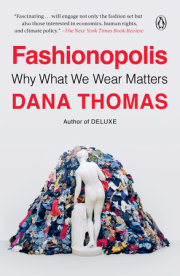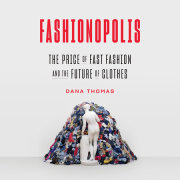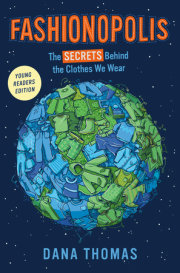ONE
Ready to Wear
On the third night of the seventy-first Cannes Film Festival, in May 2018, Australian actress and jury president Cate Blanchett floated down the red carpet in a showstopping sleeveless bubble-hem gown. The rowdy floral print began on the bodice as black-and-white line drawings, like paint-by-numbers, and eventually erupted on the voluminous skirt into full-blown Technicolor. Daring and complicated, it was exquisitely executed by Mary Katrantzou, a Greek-born, London-based women's wear designer most consumers have never heard of, though have most likely worn, after a fashion.
Katrantzou is one of the talents who creatively fuels the Fashionopolis machine: the original silhouettes she dreams up in her small London atelier are sold in limited numbers by luxury retailers in cosmopolitan capitals. This is the apex of the fashion pyramid-the same place where Gucci creative director Alessandro Michele, Louis Vuitton menswear designer Virgil Abloh, Givenchy artistic director Clare Waight Keller, and other high fashion designers sit. The clothes that Katrantzou and her confreres design are copied by fast-fashion brands on the cheap and peddled in chain stores-the massification that constitutes the broad bottom of the fashion pyramid. The "knockoffs," as the fakes are known, rake in millions for the hucksters who vend them. Katrantzou, meanwhile, receives nothing from the unauthorized global rollout of her work: no money, no glory, no acknowledgment that she ignites trends or contributes to the fashion conversation. She toils; others profit; we all wear.
Sound unfair? It is. But this trickle-down scheme-as sharply laid out by Meryl Streep in the "cerulean-blue sweater" scene in The Devil Wears Prada-is how the fashion industry works.
It begins simply enough at a wholly unglamorous semiannual trade show outside of Paris, near Charles de Gaulle airport, called Premire Vision Paris. For three days each February and September, more than sixty thousand apparel trade professionals from 120 countries descend on the multihall convention complex of Villepinte to shop the world's largest selection of future-trending fabrics and textile designs, leather, accessories, and manufacturing innovations in one place-for the February 2019 edition, there were 1,900 exhibitors. One hall is dedicated to yarns, fabrics, and sourcing solutions. Another to design, and more fabrics-some 20,000 in all. Another to leather-there are 10,000 of those. Another to accessories. The endless rows of office-gray sales stands are punctuated with installations highlighting the season's tendencies as set by thread suppliers, color companies such as Pantone, and an army of consultants who specialize in trend forecasting. Premire Vision is where every major-and many a minor-fashion brand's new season begins to take shape.
In the winter of 2018, I accompanied Katrantzou's fabric expert Raffaella Mandriota, a twenty-seven-year-old Italian metalhead who favors Maison Margiela Tabi boots, on her two-day expedition to Premire Vision-or "PV" in fashion-speak. She was scouting for the Spring-Summer 2019 women's wear collection, to be presented on a London runway nine months hence.
Her first stop was the top Italian mill, Canepa-one of her regular suppliers. After a quick hello, and an espresso, she whipped through racks and racks of jacquards, prints, and solids, called "bases," giving each one a proper look, if only for a tenth of a second, and a feel, to understand texture and pliability. When she thought one might work, she pulled it and placed it on her mounting pile-or "selection"-on the table. When she finished-in ten minutes, max-a company rep wrote up the order.
Mandriota does this twelve to fifteen times in a day at PV, thus the need for coffee; her to-do list was long. There were definite trends on view-natural dyes, seersucker, Candy Land-like colors, Lurex, hemp, iridescent silks-but the range that Mandriota chose was broad: an orange devorŽ on black chiffon; a Kelly-green viscose; a white polyester waffle-weave; a gray silk inkjet-printed with a cloudy sky; a navy, black, and evergreen Fortuny-style pleated silk with green and blue coral motif. "Beautiful, this one," she said, as she set the coral one on her stack. "Mary loves pleats."
Mandriota watched her budget carefully. "Chinese silk has gotten so expensive," she told me. "A twenty percent increase just this season. The Chinese have increased domestic consumption, so they export less. And because of pollution, the silkworm cocoons are dying."
Throughout her hunt, Mandriota peppered her vendors with questions: "What's the minimum order?" "Anything organic or sustainable?" "What other colorways are available?" "Can you print on this?" "Can you emboss on wool?" "Could you interpret Mary's design with this same jacquard technique?" In our two ten-hour days at Premire Vision, she ordered at least a thousand samples.
Six weeks later, cartons filled with swatches began to arrive at Katrantzou's studio, a prewar loft in Islington. She and her assistants conducted a first edit, and a second, and on and on, until they had whittled the mass down to a manageable array that could tell the season's story.
A Hellenistic beauty, with mink-like eyes and hair to match that falls straight to her elbows, Katrantzou was born in Athens in 1983 to a retailing family: her grandfather founded Katrantzou Spor, which was the city's largest department store until it was burned to the ground during Greece's political riots of the 1970s. Her father worked security, and her mother had an interior design shop and furniture factory.
In 2003, Katrantzou went to the United States to study interior architecture at the Rhode Island School of Design in Providence. Halfway through her sophomore year, she moved to London as an exchange student at Central Saint Martins College of Art and Design to learn textile design for interiors. "I loved the idea that textiles were about surface," she told me. "And there was an immediacy about it that I hadn't found in architecture."
Hooked, she stayed and earned a bachelor's degree in textile design and a master's in fashion with a focus on prints-at a time when fashion printmaking was moving from the more artisanal silk screen process, in which a piece of mesh cloth (originally silk), etched with an image, is stretched over a wood frame and squeegeed with ink, to digital, which is computer drawn and generated. For her MA degree show, in February 2008, she sent out ten identically shaped dresses printed with a trompe l'oeil of gigantic jewelry-magnifying common items in print on cloth has since become her leitmotif. With a grant from the British Fashion Council's young talent fund, NEWGEN, she launched her own brand during London Fashion Week the following September and landed several influential retailers, including Browns in London, Joyce in Hong Kong, and Colette in Paris.
In 2011, she won the British Fashion Award for Emerging Talent in women's wear. She has lived up to her promise-so much so that in early 2018, she sold a stake of her firm to Hong Kong-based Yu Holdings, a start-up fund founded and run by the ambitious twenty-seven-year-old Chinese fashion and technology investor Wendy Yu. (Weeks later, Yu also announced her firm was endowing the position of curator in charge at the Metropolitan Museum of Art's Costume Institute.) For Katrantzou, Yu earmarked a $20 million infusion-money that will encourage brand growth. "I think Mary could be a global lifestyle brand in the next ten to twenty years," Yu said.
As the new collection would celebrate Katrantzou's tenth anniversary, she decided it should be a best-of-meaning she'd rework former print patterns and silhouettes in a more modern, and mature, way. For themes, she chose blown-glass perfume bottles; vintage postage stamps; nature, such as insects, butterflies, and seashells; and the arts. Mandriota asked some of the textile suppliers to redo jacquard samples she'd selected at PV in Katrantzou's new print designs.
In early May, Katrantzou sat down at a wood IKEA table with Mandriota and women's wear head Gregory Amore to review the new iterations. One jacquard, a quilt-like brocade from the Italian mill Ostinelli Seta, had been proposed as chrysanthemums in grainy blues. Katrantzou kept the fabric and the technique, but replaced the flowers with a collage she created: mounds of gems, baubles, and ropes of pearls, like you'd find in a pirate's treasure chest, scattered across a coral seabed, in a palette of burnt orange, Mediterranean azure, antique gold, and iridescent white.
For solids, Katrantzou had snippets of stretch cotton poplin, sourced from various companies, that had been custom dyed, or "lab dipped," in Pantone hues she chose-sandy beige, Tiffany blue, sunshine yellow-to see how the different offerings took the color. She wasn't thrilled with the first test: the tones were a tad dull, as if rinsed in murky dishwater. Another-from a different supplier-she warmed to immediately. The colors were truer, and the quality of the cloth was clearly superior.
"Everything about this feels lighter, and somehow thicker," she said as she caressed one of the swatches. "It feels very substantial."
"It's more precious," Mandriota said.
"But it is double the price," Katrantzou said.
"Yes."
When final fabric choices arrived from mills, Katrantzou pulled a few panels and sent them off to Mumbai to be embroidered. (As needlework is still a valued skill in India, it is a center for handcrafted fashion embellishments.) Garment samples were made, either by her in-house atelier or a contracted factory-she relies on two in Italy, one in Portugal, and three small family-owned workshops in the UK that do short runs of twenty to fifty pieces. For six weeks, she conducted fittings on her longtime house model Julia, a leggy blonde from Sweden. "Julia has an opinion on the aesthetic," Katrantzou said. "She understands the fit, and advises us."
In late June, Katrantzou presented her finished "precollection," which is in the more commercial range, to retailers in a Paris showroom she rented during menswear week. (Buyers hit men's shows and women's precollections on the same trip.) The space was gloriously belle epoque Parisian: a one-floor walk-up with patinaed oak paneling, herringbone parquet, and arched windows with a view on the Place des Victoires. The finished clothes, hanging on racks and presented informally on models, were colorful and enticing. Retail buyers examined each item thoughtfully and, over coffee and petit fours at small tables, placed their orders. Katrantzou sat down with them and listened to their opinions and observations. Sometimes she'll tweak her designs to incorporate their counsel.
The flashiest, most photographable pieces-the sort like Blanchett wore in Cannes-Katrantzou saved for her "show collection," which she presented during London Fashion Week in September. At eight on a Saturday night, retailers, editors, bloggers, and scribes filed into the Roundhouse, a rock concert venue in north London, for the show. Thirty-five models slowly emerged, one by one, and walked the circular runway to an ethereal score Katrantzou had commissioned from her friend and fellow Greek, the Oscar-winning electro-jazz composer Vangelis. As they passed, I spotted a few materials Mandriota had selected at PV: the organza base on which the stamp motif was printed for swishy day dresses; a fine transparent plastic that Mandriota had pleated in Japan, layered over geometric shifts; a white tulle embroidered with cascading wildflowers for a romantic trapeze midi. The audience cheered as Katrantzou skipped around the runway and took her bow, and the next morning, the critics laid on the praise. Vogue.com: "a walking wunderkammer of a collection." The New York Times: "opulent mosaics of print and polygons." Women's Wear Daily: "fun," especially "fantastic pieces" like the "shimmery floor-length gown with a perfume bottle picked out in sequins down the front" and "flowing nylon dresses . . . printed with famous works of art."
But before any of those reviews were posted, Katrantzou's show guests had uploaded pictures and video clips of the looks on social media, often live. And design teams for fast-fashion brands had perused those images, noted the number of "likes"-an instantaneous, and free, market study-and chosen which designs they would steal, loosely reinterpret, and produce offshore for pennies apiece. (As I walked out of the show, a top online retail executive mused: "I bet TopShop is already working on that butterfly print.") Katrantzou's design work would result in global trends, but she would have no say or stake in the matter.
"It takes three months to produce the forty prints we develop each season," Katrantzou told me. And it takes a click of a smartphone camera to loot them from her that hurts her business, of course. But it also damages "the whole collective of designers working with digital print, because copying digital print has become so easy," she said. As she well knows, the moment we stop protecting artists and their work-be it words, images, or design-there will be less organic creation, fewer new ideas.
In a matter of weeks, the faux Katrantzous would be churned out in chintzy fabric by poorly paid workers along a fragmented global supply chain and appear in stores retailing for less than one hundred dollars-one-tenth, or less, what the far more intricate and luxurious originals would command.
Those tons of garments would be worn briefly, then jettisoned. What remained on the rack for more than a week or two would be marked down, and marked down again-to as little as $3.99-looking sadder and limper with every rejecting whisk of the hanger. Eventually, management would yank the leftovers from circulation and shred or burn them.
This is how the fashion business has functioned on a grand scale for 250 years: creative thievery, indifference for others, corruption, pollution. Ever since an English entrepreneur decided that faster was better.
Nobody really liked Richard Arkwright. A barber and wigmaker by training, he was pompous, litigious, and generally repulsive. ÒA plain almost gross, bag-cheeked, potbellied Lancashire man,Ó Scottish historian Thomas Carlyle wrote in 1839, Òwith an air of painful reflection, yet also copious free digestion.
Worse, Arkwright had the habit of stealing other people's ideas-such as Lewis Paul's carding machine and James Hargreaves's spinning jenny-improving them, and using them to his own profit. (Several of his patents were later challenged in court.) In 1771, he pulled together some of these newfangled machines and opened the world's first water-powered textile mill, in Cromford, Derbyshire. With that, Arkwright kicked off the Industrial Revolution-the transition from handmade to machine-made-giving rise to the factory system we still rely on today.
Clack-clack-clackety-clack the machines roared, shaking the five-story building, cotton filaments filling the air like a snowy fog. The days were long: thirteen-hour shifts with two short breaks for meals; the mills stopped only for one hour. Workers lived in Arkwright-built brick row houses on the factory grounds and attended an Arkwright-built church. At first, there were two hundred workers; within a decade, a thousand. Local textile factory owner William Radcliffe observed that between 1770 and 1778, "complete change had been effected in the spinning of yarns . . . Wool had disappeared altogether . . . Cotton had become the universal material." By 1790, Arkwright owned nearly two hundred mills throughout the country, and Manchester had become known as "Cottonopolis."
Copyright © 2019 by Dana Thomas. All rights reserved. No part of this excerpt may be reproduced or reprinted without permission in writing from the publisher.







